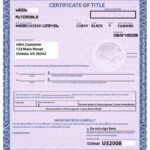Bill of Sale with Title: A Complete Legal Guide for Vehicle Transactions
Bill of Sale with Title: A Complete Legal Guide for Vehicle Transactions
[caption id="attachment_379" align="aligncenter" width="150"] Car Title Sale[/caption]
Car Title Sale[/caption]When transferring ownership of a vehicle, a bill of sale with title is a legally essential combination of documents that finalizes the transaction and protects both the buyer and the seller. The process involves more than just exchanging keys; it includes a series of well-defined legal steps and document submissions that ensure compliance with state and federal laws. Below is a comprehensive guide detailing every crucial aspect of using a bill of sale in conjunction with a title transfer.
Understanding the Bill of Sale and Vehicle Title
What Is a Bill of Sale?
A bill of sale is a legal document that serves as a receipt for the transaction and records key information about the sale. It acts as proof that a vehicle has been sold and includes essential details such as:
Names and addresses of the buyer and seller
Date of the sale
Sale price
Vehicle description (make, model, year, VIN)
Odometer reading
Terms of the sale, including “as-is” clauses
What Is a Vehicle Title?
The vehicle title, also known as a certificate of title, is the official document issued by the state’s Department of Motor Vehicles (DMV) that proves legal ownership of a car. It contains information such as:
Legal owner’s name and address
Vehicle Identification Number (VIN)
Make, model, year, and body type
Any recorded liens or encumbrances
Odometer disclosure section
Why Both Documents Are Needed for a Legal Sale
The bill of sale documents the transaction, while the vehicle title legally transfers ownership. Both are critical to prevent disputes, ensure DMV compliance, and protect against fraud.
Bill of sale = Proof of purchase
Title = Proof of ownership
Together, they establish a complete chain of custody from seller to buyer.
Key Components of a Valid Bill of Sale with Title
1. Accurate Vehicle Description
To prevent confusion or fraud, both documents must list:
Make, model, and year
VIN (Vehicle Identification Number)
Body style and color
Current mileage (odometer reading)
Ensure consistency across both documents.
2. Identifiable Buyer and Seller Information
Include:
Full legal names
Physical addresses
Driver’s license numbers (recommended for verification)
This ensures traceability in case of legal disputes or DMV discrepancies.
3. Sale Price and Payment Terms
Clearly state:
Agreed sale amount
Whether the transaction was cash, a certified check, a bank transfer, or another method
If the vehicle is being sold “as-is” without warranties
As-is clauses should be included in both documents to limit seller liability.
4. Signatures and Dates
Both parties must sign and date both the bill of sale and the title. In some states, notarization is required, particularly if the title includes a lien release.
How to Properly Fill Out the Vehicle Title
Each state may have different formatting, but the typical steps include:
Locate the “Assignment of Title” or “Transfer by Owner” section on the back of the title
Enter the buyer’s full legal name and address
Input the sale price and date of sale
Fill in the odometer disclosure
Signatures of both buyer and seller
If there is a lienholder, ensure the lien release section is completed or submit a separate notarized lien release letter with the transaction.
State-Specific Requirements for Bill of Sale and Title Transfer
California
A bill of sale is recommended but not required by DMV
The title must include odometer disclosure and signatures
Smog certification must be provided by the seller
Texas
A bill of sale is strongly encouraged
Submit Form 130-U (Application for Texas Title and/or Registration)
Both parties must sign the title
The seller must file a Vehicle Transfer Notification
Florida
Notarized bill of sale required
Seller must submit Form HSMV 82050
Both parties sign and complete the title transfer at the DMV
New York
Bill of sale required
Odometer disclosure mandated
Buyer files MV-82 (Vehicle Registration/Title Application)
Seller surrenders license plates to the DMV
Always verify with your local DMV to ensure full compliance.
Legal Protections Afforded by a Bill of Sale with Title
For Sellers
Protects against future liability (accidents, parking tickets, toll violations)
Serves as evidence in case of buyer disputes
Record the ale price to support income tax reporting
For Buyers
Serves as a receipt for payment
Protects against fraudulent title claims
Establishes legal ownership in combination with the title
What Happens if One of the Documents Is Missing
No Bill of Sale: Buyer may struggle to prove they legally acquired the vehicle, especially in private party sales
No Title: The buyer cannot register the vehicle or prove ownership legally. A duplicate title must be requested from the DMV
Unreleased Lien: Title cannot be transferred until the lienholder provides a formal release
Never finalize a sale without both a properly completed bill of sale and a vehicle title.
Sample Bill of Sale Template
When to Notarize the Documents
Some states require notarization of:
Title transfer signatures
Lien release letters
Bill of sale (especially when a buyer is registering the vehicle out-of-state)
Check with your local DMV or use a mobile notary for convenience.
Final Steps After Completing the Sale
Seller: Submit a release of liability form to your DMV
Buyer: Visit the DMV to register the vehicle in your name
Tax Considerations: The buyer may be liable for sales tax based on the bill of sale amount
Insurance: Buyer must obtain active insurance before registration
Keep Copies: Both parties should retain copies of the bill of sale and title
Conclusion: Ensuring a Legal Vehicle Transfer
A bill of sale with title is the foundation of a secure and legal vehicle sale. These two documents, when completed accurately and comprehensively, protect both parties, meet all DMV requirements, and prevent legal issues down the road. Never proceed with a vehicle transaction without ensuring both the bill of sale and title transfer are properly executed.
Comments
Post a Comment